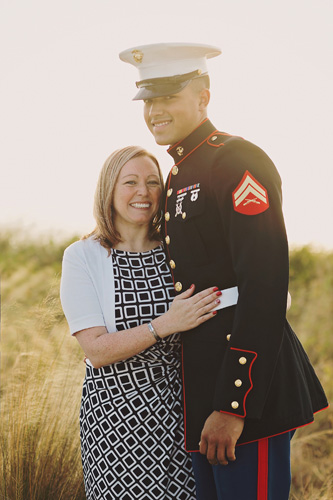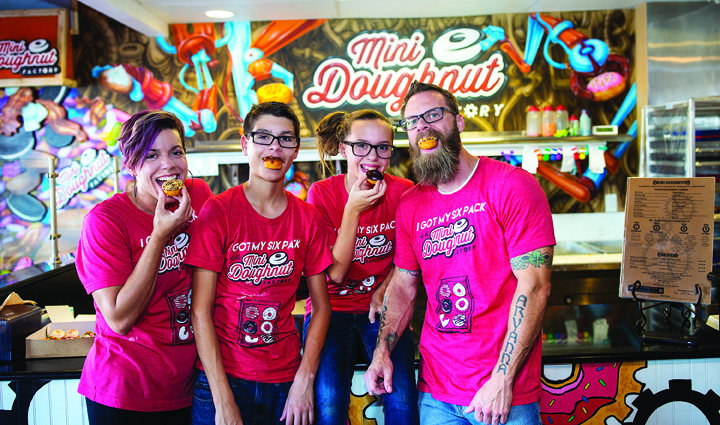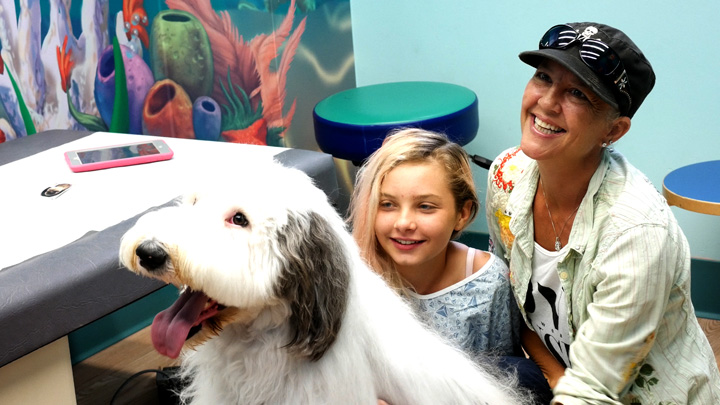
It is Saturday night in Wesley Chapel, a typical summer night where a 90º+ day has given way to a torrential downpour. But, inside chilly Florida Hospital Center Ice (FHCI), the atmosphere couldn’t be a more perfect for the Tampa Bay Curling Club (TBCC).
A cart with plastic pitchers of beer is hoisted onto a rink — where stones and brooms and a collection of mismatched locals with rubber bands on their shoes (to keep from slipping) — men and women, ranging in ages from 15 to 70, are ready for their favorite night of the week.

In a cacophony of stones clacking together and teammates cheering each other on, club president Bernie Skerkowski’s voice seems to boomerang off the boards.
“No……no……Yes! Sweeeeeep! Sweeeeeep!”
Skerkowski teaches the sport and runs the curling program at FHCI, but he also is on a team — Curl Jam — in the inaugural season of curling that is now less than halfway through its first season in the Tampa Bay area. He is exhorting his teammates to brush the ice, which is covered with tiny droplets of water that harden into little pebbles of ice, and smooth it out so the 42-pound stone that he has just slid towards the “house,” or target, can pick up some steam and trajectory.
“Sweeeeeeeeeeeep!”

When the stone finds its mark inside the house, he flashes a smile towards his teammates, and is greeted with two thumbs up.
This happens on all five sheets (or rows) of ice on one of the three NHL-sized rinks every Saturday night at FHCI, over and over, by an enthusiastic group excited about being curling pioneers in Wesley Chapel. The “Spirit of Curling,” a common phrase used in the game by players to describe the sportsmanship, camaraderie and etiquette that is supposed to define the sport, is on display.
“We can’t wait for Saturday nights,’’ said DJ Bonoan, a computer engineer who formed a team, House of Chapel, with his friends Noah Bethel, Orlando Rosales and Billy Still.
Bonoan and his teammates have so embraced curling’s arrival, he is documenting their first season on a blog called TheHadjiChronicles.com, where he posts a video series he shoots and edits called “STONED.”
 “We’re always thinking about it,’’ Bonoan says. “I’m at work, looking at better strategies for playing, looking for game plans, trying to figure out better ways to get the stone down the ice. Man, we love it!”
“We’re always thinking about it,’’ Bonoan says. “I’m at work, looking at better strategies for playing, looking for game plans, trying to figure out better ways to get the stone down the ice. Man, we love it!”
Bonoan has even downloaded a curling game app for his cell phone.
Skerkowski isn’t surprised that Bonoan and others have quickly developed an obsession with curling.
He and FHCI general manager Kevin Wolter had talked about hosting a curling league long before the doors were even open at the facility, with both feeling it would be a big hit in the community.
When they were able to convince developers to build room for five sheets of curling ice (one sheet for each game being played), they knew they could make it work. “I am still a little surprised,’’ Skerkowski says. “It’s more people than I expected. When we had our informational meeting, I thought we’d get 30-40 people out, but we had 100.”
Big Numbers, Big Fun!
The TBCC (visit TampaBayCurlingClub.com) currently has 63 members, and 80 percent of them had no curling experience when they signed up. The league, which has 10 teams, is co-ed, although, if interest increases, Skerkowski is open to a women’s-only league in the future.

The league already utilizes five sheets every Saturday. The Orlando Curling Club, which has been around for a few years, usually only has access to three or four, according to Skerkowski.
“They can’t believe how many we’ve got,’’ says Skerkowski.
The league has recently been accepted into the Grand National Curling Club (GNCC), a 150-year-old organization that has more than 4,700 members, or roughly a quarter of all curlers in the U.S., according to its website. Skerkowski says getting in the GNCC was a coup for a club so young.
“Even they (GNCC) were surprised by how many members we have,’’ he said.
The current TBCC league, which was about to complete (at our press time) the fourth week of a 10-week season, is just the tip of the, well…iceberg.
By the start of the next season, an influx of snowbirds returning to Florida and word of mouth is expected to increase the number of local curling participants. The 2018 Winter Olympics will be held in February in PyeongChang, South Korea, which will give the sport another boost, with the TBCC expecting to see an influx of new members as a result.
Wolter says there could also be plans for a Sunday morning league, which are very popular up north, as well as bonspiels, or weekend tournaments.
 “It has been very successful so far, so we can definitely see this expanding into a number of different things,’’ he says.
“It has been very successful so far, so we can definitely see this expanding into a number of different things,’’ he says.
Curling reminds many of shuffleboard, a popular game with the older set in Florida, although it is more commonly referred to as “chess on ice” and dates back to the 1500s.
Each game is played on a rectangular sheet of ice which is roughly 150 feet long and 16 feet wide. At FHCI, the five sheets of ice are laid down side. The ice is “pebbled,” a process where small droplets of water are frozen across the surface. Without pebbling, Skerkowski says, the stone would barely move. With it, the stone is able to glide more effectively and spin, or curl…hence the name.
While players take turns “throwing,” or pushing, the stone, their teammates play the role of sweepers, using a broom to brush the ice to the front and side of the stone. The brushing reduces friction underneath the stone and allows its path, speed and spin to be manipulated.
 Teams alternate shots and are aiming for the house, the area that looks like a target, as they try to score points for being closest to the center. Each team throws eight stones to complete an “end” (or inning, like in baseball). Although the number varies, a typical match consists of eight ends.
Teams alternate shots and are aiming for the house, the area that looks like a target, as they try to score points for being closest to the center. Each team throws eight stones to complete an “end” (or inning, like in baseball). Although the number varies, a typical match consists of eight ends.
“When we were first got here, I was thinking, ‘How hard could this be?,’’’ says Bonoan, who is no stranger to working out. “But, I’ll tell you this, it’s a lot more challenging than it looks on TV. I was actually sore after the first Learn To Curl class.”
Although curling is huge in Canada — where national finals are televised — and in the northern U.S. (it has even been featured in an episode of “The Simpsons”), the only time most Americans ever see the sport is during the Winter Olympics.
The game enjoyed a spike in popularity when it returned as an Olympic sport in 1998, after its exclusion from the Olympic programs since 1924. In 2010, it was prominently featured during Olympic TV coverage, creating another boost of popularity. “People laugh at it, but when it is on during the Olympics, everybody watches it,” Skerkowski says.
Catching The Fever…
New Tampa resident Raquel Aluisy, who convinced best friend Janice Tuffy to join her and started researching the sport before it even started at FHCI (only to find the closest clubs were in Orlando or Fort Myers), says “I remember curling during the Olympics, watching it at 3 a.m. when I was little, and thought it looked so cool and fun,’’ Aluisy says. “A couple of months later, they announced it at Center Ice and I called Janice and said ‘WE’RE DOING IT!’”
 Raquel and Janice met Chris Ansey and Dave Hobbs at one of the Learn To Curl classes in May, and decided to form a team, Kuch’s Kurlers, for the league.
Raquel and Janice met Chris Ansey and Dave Hobbs at one of the Learn To Curl classes in May, and decided to form a team, Kuch’s Kurlers, for the league.
“Everybody was just so friendly and nice,’’ she says. “We all learned together, fell together and got back up together.”
Raquel tried to recruit others, “but all my friends at work think I’m crazy.”
Saturday night may not ideal for many, but Raquel has no problem making her way to Wesley Chapel for league matches. At least, so far. A Tampa Bay Lightning season ticketholder, she expects a few of the hockey games to conflict with her curling career. “That will be a tough choice,” she says, laughing.
Mike Meyers of Dade City watched curling during the last Olympics, and when he read that an ice rink was being built nearby, he told his wife if they ever started curling, he was going to play.
One of the first few curlers to sign up at FHCI, Meyers and his son Chris, who is 15, play on Get Your SHEET Together. On a recent Saturday night, Chris found the bulls eye a few times, although the team fell short against License to Curl.
 “He’s not a big sports kid at all, but he has picked it right up,’’ Mike said.
“He’s not a big sports kid at all, but he has picked it right up,’’ Mike said.
Their teammates, Danny Winters and his fiancé Liz Mitchell of Wesley Chapel, signed up together. Danny says he was debating trying the sport out after stumbling across a curling demo one day at FHCI, when his 8-year-old son Avery nudged the guy at the sign-up table and said ‘My dad wants to try it out.’”
That guy happened to be Skerkowski, who closed the deal with Winters.
“I was along for the ride,’’ said Mitchell, who admits she has also developed a fondness for the sport.
It’s not cheap to curl, a fact that nearly scared off Mitchell and others.
To join the Tampa Bay Curling Club, the annual dues are $75 (which covers insurance) and to register a team is $250 (or what amounts to $25 a match). That comes out to $250 per player, though Skerkowski says a team of eight that alternates the weeks they play cuts that in half.
Ice time is not cheap. In fact, the league started a three-week hiatus after the games June 24 because other scheduled events need the rink. And creating the particular curling sheets is time consuming. “We’ve made it as cheap as possible,’’ he says. “Nobody is making any money off this.”
 While the club provides some brooms, most members have gone online to buy their own, which start at around $50 for a fiberglass version if you shop around. There are specially-made curling shoes, which is another cost for the serious player, there are slider slippers to share and you can get by with rubberbands to keep from slipping.
While the club provides some brooms, most members have gone online to buy their own, which start at around $50 for a fiberglass version if you shop around. There are specially-made curling shoes, which is another cost for the serious player, there are slider slippers to share and you can get by with rubberbands to keep from slipping.
You do not, however, need the most expensive piece of equipment, the stone. The FHCI is leasing 16 of the granite stones for the league, for a cost of $6,000 a year, but will eventually own them.
Some teams have also decided to buy matching uniforms for the games.
“It’s been worth every penny,’’ says Bonoan. “I can’t wait to see what other stuff they have planned.”
For more information about upcoming Learn To Curl Classes, current league standings and future leagues, visit TampaBayCurlingClub.com or contact president Bernie Skerkowski at (813) 758-2279.














